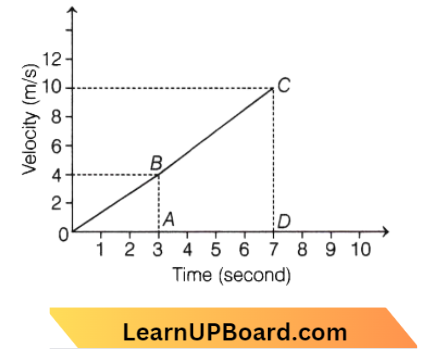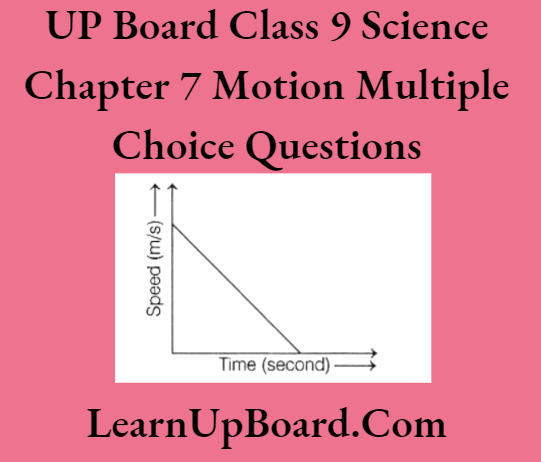UP Board Class 9 Science Chapter 7 Motion Multiple Choice Questions
Question 1. The minute hand of a wall clock is 14 m long. The distance and displacement covered by the tip of the minute hand from 9: 00 am to 9: 30 am, are
- 88 cm, 28 cm
- 28 cm, 44 cm
- 28 cm, 88 cm
- 44 cm, 28 cm
Answer: 4. 44 cm, 28 cm
Distance =\(\pi r=\frac{22}{7} \times 14=44 \mathrm{~cm}\)
Displacement = 2r = 2×14 = 28 cm

Question 2. If the velocity of an object decreases with time, then it is called
- retardation
- de-acceleration
- negative acceleration
- All of the above
Answer: 4. All of the above
When the velocity of an object decreases with time, then it is said to be retardation, de-acceleration or negative acceleration.
Question 3. A speedometer is a device which is used to measure
- average speed
- average acceleration
- instantaneous speed
- instantaneous acceleration
Answer: 3. instantaneous speed
A speedometer is used to measure instantaneous speed.
Question 4. An object travels 24 m with a speed of 4 m/s and then another 32 m with a speed of 8 m/s. The average speed of the object is
- 6 m/s
- 4 m/s
- 5.6 m/s
- 6.5 m/s
Answer: 3. 5.6 m/s
Time travel to cover 24 m with a speed of 4 m/s,
Time Travel, \(t_1=\frac{24}{4}=6 \mathrm{~s}\)
Time travel to cover 32 \(\mathrm{~m}\) with speed 8 \(\mathrm{~m} / \mathrm{s}\),
⇒ \(t_2=\frac{32}{8}=4 \mathrm{~s}\)
⇒ \(\text { Average } \text { speed }=\frac{\text { Total distance }}{\text { Total time }}=\frac{24+32}{t_1+t_2}\)
= \(\frac{56}{6+4}=5.6 \mathrm{~m} / \mathrm{s}\)
Question 5. A body moves on a circular path with a uniform speed of 6 m/s. If the body completes one revolution in 22 seconds, then the radius of the circular path is
- 21 m
- 7 m
- 14 m
- 28 m
Answer: 1. 21 m
Given, speed, v=6 m/s, time period, T=22 s
v=\(\frac{2 \pi r}{T}\)
r =\(\frac{v T}{2 \pi}=\frac{6 \times 22 \times 7}{2 \times 22}=21 \mathrm{~m}\)
Question 6. A bridge is 400 m long. A 150 m long train crosses the bridge at a speed of 50 m/s. Time taken by the train to cross it.
- 5 s
- 8 s
- 6 s
- 11 s
Answer: 4. 11 s
Total length of path covered by train = 400 + 150 = 550m
Time taken by train to cross the bridge
= \(\frac{\text { Total distance }}{\text { Speed }}=\frac{550}{50}\)=11 s
Question 7. If a body is moving on a circular path of radius 21 cm with a velocity of 2 m/s, then the time taken by the body to complete half revolution is
- 11s
- 22 s
- 44 s
- 33 s
Answer: 4. 33 s
Given, radius, r=21 cm and velocity, v=2 m/s
Time period (T)=\(\frac{2 \pi r}{v}\)
Half-time period (T)=\(\frac{\pi r}{v}=\frac{\frac{22}{7} \times 21}{2}=33 \mathrm{~s}\)
Question 8. A velocity-time graph for a moving object is found to be a curved line, then its acceleration is
- constant
- variable
- zero
- None of these
Answer: 2. variable
Since the velocity-time graph for a moving object is a curved line, this means that the object is moving with non-uniform accelerated motion, therefore the body is moving with variable acceleration.
Question 9. In the following figure of the velocity-time graph for the motion of the body, the total distance covered by the body from 3 s to 7 s is

- 28 m
- 56 m
- 14 m
- 35 m
Answer: 1. 28 m
Total distance moved by the body from 3 s to 7 s
= Area of shape ABCD =\(\frac{(A B+D C) \times A D}{2}\)
=\(\frac{(4+10)(7-3)}{2}=\frac{14 \times 4}{2}=28 \mathrm{~m}\)
Question 10. The speed-time graph in the following figure indicates the body starts from a certain initial velocity and accelerates

- the body has a certain initial speed and then its speed decreases to zero
- the body has constant acceleration
- None of the above
Answer: 2. The body has a certain initial speed and then its speed decreases to zero.
Question 12. In a uniform circular motion, angular displacement is measured in
- radian
- steradian
- meter
- radian/second
Answer: 1. radian
Angular displacement is measured in radians.
Question 13. When two bodies move uniformly towards each other, then they cross each other at the speed of 10 m/s. If both the bodies move in the same direction, then they cross each other at the speed of 6 m/s. The speed of both bodies are
- 8 m/s, 2 m/s
- 8 m/s, 4 m/s
- 6 m/s, 2 m/s
- 6 m/s, 4 m/s
Answer: 1. 8 m/s, 2 m/s
Let \(v_1\) and \(u_2\) be the speeds of two bodies, then
⇒ \(u_1+u_2\)=10
(when they are moving in the opposite direction) → Equation 1
⇒ \(u_1-u_2\)=6
(when they are moving in the same direction) → Equation 2
Solving Eqs. (1) and (2), we get
∴ \(u_1=8 \mathrm{~m} / \mathrm{s} \text { and } u_2=2 \mathrm{~m} / \mathrm{s}\)
Question 14. A cyclist appears to be stationary with respect to another moving cyclist, then both cyclists are moving
- In the opposite direction with the same velocity
- In the same direction with the same velocity
- In the perpendicular direction with any velocity
- In the perpendicular direction with the same velocity
Answer: 2. In the same direction with the same velocity
When both cyclists are moving in the same direction with the same velocity, then they appear to be stationary.
Question 15. The ratio of displacement and distance is
- <1
- >1
- >1
- None of these
Answer: 2. >1
Question 16. A body moves in a circular path radius of 10 cm. If it completes two revolutions along the circular path, then the displacement of a body is
- zero
- 40 cm
- 20 cm
- None of these
Answer: 1. zero
Question 17. If a car moves along a straight line path, that covers an equal distance in equal intervals of time, it is said to be
- In non-uniform motion
- In uniform motion
- Both (1) and (2)
- None of the above
Answer: 2. In uniform motion
Question 18. The SI unit of acceleration is
- m/s
- m2/s
- m/s2
- s/m
Where m is the meter and s is the second.
Answer: 3. m/s2
Question 19. Which of the following is an example of a uniform acceleration?
- The motion of a free-falling body
- The motion of a ball rolling down on an inclined plane
- Both (1) and (2)
- None of the above
Answer: 3. Both (1) and (2)
Question 20. Which of the following statements is correct?
- The average speed of an object can never be zero
- The average velocity of a moving object can be zero
- The motion of the moon and the earth is a uniform circular motion
- All of the above
Answer: 4. All of the above
Question 21. Uniform circular motion
- Is an accelerated motion
- Is an unaccelerated motion
- Have uniform velocity
- None of the above
Answer: 1. Is an accelerated motion
Question 22. A wheel completes 2000 revolutions to cover the 9.5 km distance, then the diameter of the wheel is
- 1.5 m
- 1.5 cm
- 7.5 cm
- 7.5 m
Answer: 1. 1.5 m
